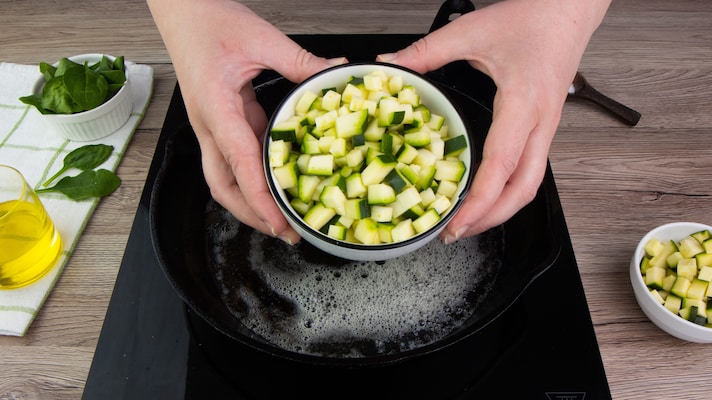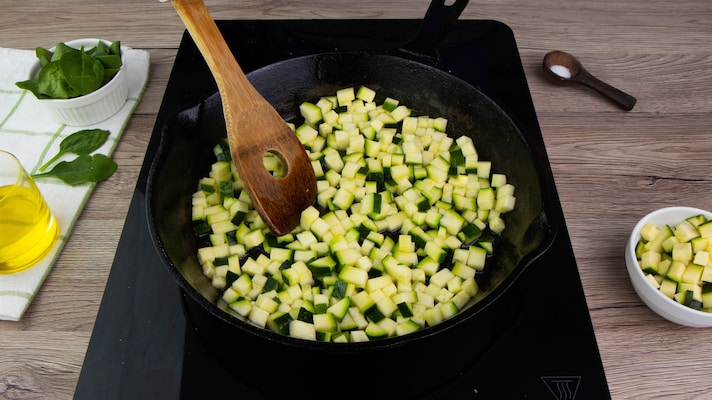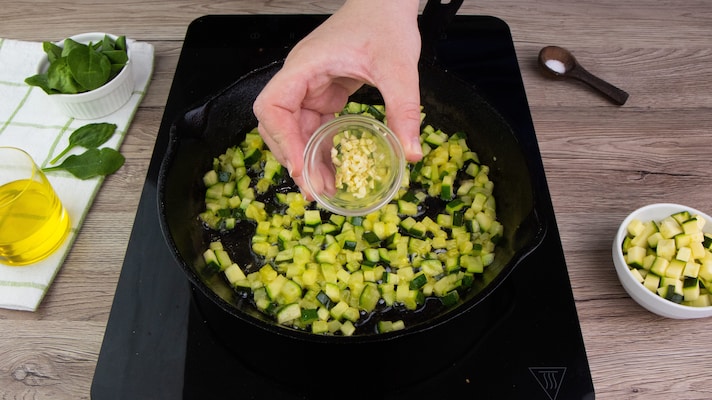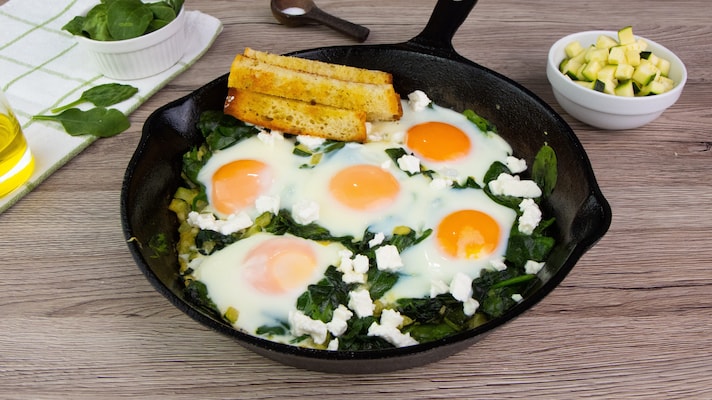
Green Shakshuka: the vegetarian, one-pan recipe for your healthy breakfast

Shakshuka is a traditional North African breakfast, also popular in the Middle East. If you’re looking for a complete, all-in-one breakfast, then you should definitely look to a shakshuka. In a traditional shakshuka, eggs are cooked in a rich, tomato sauce with paprika and cumin. A green shakshuka is instead made with green vegetables as a base for the stem-poached eggs—it’s a green variation of the classic.
While it’s often eaten for breakfast, it’s great for lunch and dinner too! It’s an easy, healthy, one-pan, vegetarian dish. Packed with not only flavor but also nutrients, this will be your new go-to dish. You can even customize it as you want, so make sure to check out our tips below. You only need a few basic ingredients (bread, eggs, vegetables) and you’re set for a delicious, satisfying meal in one pan.
Green Shakshuka Ingredients
Bread – for the breadsticks you can use older bread, no need to buy a fresh loaf.
Herbs – go for parsley or cilantro.
Vegetables – for this recipe, you’ll need zucchini and spinach.
Eggs – use large, free-range eggs.
Spices – stick with salt and pepper, or go for a more traditional taste with paprika and cumin.
How To Make Green Shakshuka
First, make the breadsticks. Cut the bread into sticks and arrange it in the pan. Sprinkle with olive oil and seasoning. Bake until golden. Now prepare the green shakshuka sauce. Cook the chopped zucchini and add a handful of spinach.
Once the spinach is wilting, add the eggs in small indents. Cook and then top with feta. Toss to wilt and then make gaps amongst the vegetables, dotting the gaps.
Tips
Make the green shakshuka vegan by using vegan feta, and substituting the eggs with tofu.
You can add meat to this recipe (like ground beef, chicken, or lamb). Simply cook the meat before adding the spinach.
If you see your sauce is too watery, you can thicken it. Increase the cooking time to reduce the liquid. Or add a bit of cornflour or mashed potato.
You can use swiss chard if you’re unable to find baby spinach.
You can add tomatillo, it will taste similar to traditional shakshuka, but will still be green. If using canned tomatillo, add a teaspoon of sugar to offset the acidity.
What To Eat With Green Shakshuka
Green Shakshuka can be eaten as breakfast, lunch, and even dinner. Serve it with breadsticks as in this recipe or fresh bread like pita or challah.
Add a salad, and it makes a good lunch. Serve with extra feta and sliced avocado.
How To Store Green Shakshuka
This dish is best served fresh because the eggs don’t hold up well to reheating. But if you want, you can reheat the sauce in a saucepan over medium heat.
Can You Freeze Green Shakshuka?
You can freeze the Green Shakshuka without the eggs. Simply cook the vegetables and allow them to cool. Store it in the freezer in an airtight container for up to 3 months.
When you’re ready to eat, allow it to thaw in the fridge. Transfer to a hot pan, heat, and then add the eggs.
More Recipes You'll Like
Ingredients
Instructions

Cut the bread into sticks and arrange it in the pan.
Cut the bread into sticks and arrange it in the pan.

Sprinkle with olive oil and salt.
Sprinkle with olive oil and salt.

Flavor with herbs.
Flavor with herbs.

Cook until the breadsticks are golden brown on all sides.
Cook until the breadsticks are golden brown on all sides.

Melt butter in a frying pan, add the zucchini cut into small pieces.
Melt butter in a frying pan, add the zucchini cut into small pieces.

Pan-fry the zucchini.
Pan-fry the zucchini.

When starting to brown, add the chopped garlic, salt, pepper.
When starting to brown, add the chopped garlic, salt, pepper.

Once the zucchini is almost cooked, add a couple of handfuls of spinach. Toss to wilt and then make gaps amongst the vegetables, dotting the gaps.
Once the zucchini is almost cooked, add a couple of handfuls of spinach. Toss to wilt and then make gaps amongst the vegetables, dotting the gaps.

Crack the eggs into the gaps between the vegetables.
Crack the eggs into the gaps between the vegetables.

Let the eggs cook.
Let the eggs cook.

Crumble in the feta once the eggs are cooked.
Crumble in the feta once the eggs are cooked.

Serve and enjoy!
Serve and enjoy!
Notes
The eggs for the green shakshuka should be runny, so make sure to not overcook the eggs.
;Resize,width=767;)


;Resize,width=712;)
